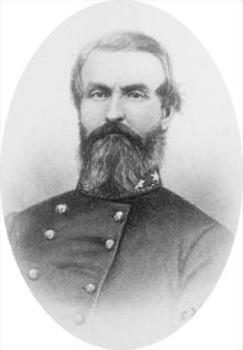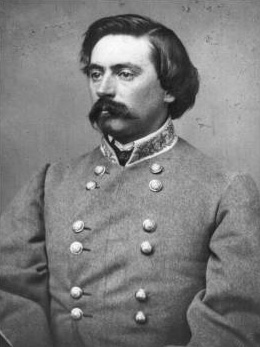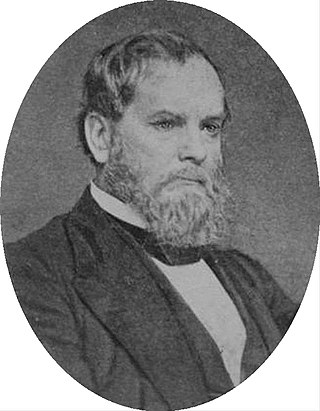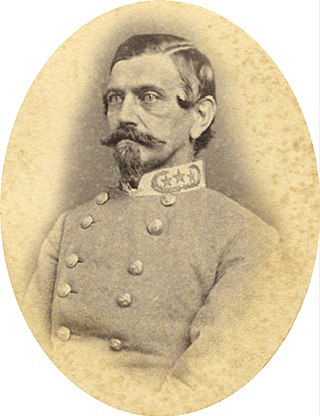
Paul Jones Semmes was a banker, businessman, and a Confederate brigadier general in the American Civil War, mortally wounded at the Battle of Gettysburg.

Brigadier-General Clement Anselm Evans was a senior officer of the Confederate States Army who commanded infantry in the Eastern Theater of the American Civil War. Afterwards, he edited a 12-volume work on Confederate military history, so named, in 1899.

Thomas Taylor Munford was an American farmer, iron, steel and mining company executive and Confederate colonel and acting brigadier general during the American Civil War.

Pierce Manning Butler Young was an American soldier, politician, diplomat, and slave owner. He was a major general in the Confederate States Army during the American Civil War, and after the war a four-term United States Congressman from Georgia, before serving in the diplomatic corps.

John Randolph Chambliss Jr. was a career military officer, serving in the United States Army and then, during the American Civil War, in the Confederate States Army. A brigadier general of cavalry, Chambliss was killed in action during the Second Battle of Deep Bottom.

Pinckney Downie Bowles was a lawyer, county prosecutor, probate judge, and a Confederate military officer during the American Civil War.

Montgomery Dent Corse was an American banker, gold prospector, and soldier who served as a general in the Confederate States Army during the Civil War. He commanded the 17th Virginia Infantry and then Corse's Brigade of Pickett's Division in the Army of Northern Virginia, and served in several of that army's most important battles.

The 1st Arkansas Infantry (1861–1865) was a Confederate Army infantry regiment during the American Civil War. The regiment was raised in April 1861 by Colonel Thompson B. Flournoy. It moved first to Virginia, but transferred back to Tennessee and served the rest of the war in the western theater, seeing action in the Kentucky, Tennessee and Georgia campaigns. Following its depletion in numbers, the regiment was consolidated several times with other Arkansas regiments, finally merging in 1865 into the 1st Arkansas Consolidated Infantry Regiment. There were three regiments known as "1st Arkansas" during the war. The second unit with the designation of "1st Arkansas" was the 1st Infantry, Arkansas State Troops, which was mustered into Confederate service at Pitman's Ferry, Arkansas, on 23 July 1861, under the command of Colonel Patrick Cleburne; this unit was eventually redesignated as the 15th Arkansas Volunteer Infantry. The third unit bearing the title "1st Arkansas" was the 1st Arkansas Volunteer Infantry, which served with the Union Army.

William Edwin Starke was a wealthy Gulf Coast businessman and a brigadier general in the Confederate States Army during the American Civil War. He was killed in action at the Battle of Antietam while commanding the famed "Stonewall Division," a unit first made famous under Stonewall Jackson.
The 2nd Arkansas Infantry was an army regiment of the Confederate Army during the American Civil War. The regiment was raised in May 1861 under Colonel Thomas C. Hindman. It served throughout the war in the western theater, in the Confederate Army of Tennessee, seeing action in the Kentucky, Tennessee and Georgia campaigns. Following its depletion in numbers, the regiment was consolidated several times with other Arkansas regiments, finally merging in 1865 into the 1st Arkansas Consolidated Infantry Regiment. The regiment has no connection with the 2nd Regiment, Arkansas State Troops, which participated in the Battle of Wilson's Creek, and is also separate from the 2nd Arkansas Consolidated Infantry Regiment, which was formed in 1864 from remnants of regiments surrendered at Vicksburg and Port Hudson.

Theodore Washington Brevard Jr. was best known for having served as a military officer in the Confederate States Army. During his tenure with the Confederate army, he eventually reached the rank of Brigadier-General. Brevard was captured by the forces of General George Custer and imprisoned at Johnson's Island. He later died in 1882.

John Dunovant was a brigadier general with temporary rank in the Confederate States Army during the American Civil War. Dunovant was a native of South Carolina who had been a Mexican–American War veteran and captain in the U.S. Army from March 3, 1855, to December 29, 1860. During the Civil War, he was commander of the 1st South Carolina Regulars and later the 5th South Carolina Cavalry Regiment. He was in command of a cavalry brigade in the later part of the Overland Campaign and the early part of the Siege of Petersburg. He was killed at the Battle of Vaughan Road on October 1, 1864, during the Siege of Petersburg.

Adley Hogan Gladden was lieutenant colonel and second commander of the Palmetto Regiment of South Carolina volunteers during the Mexican–American War and a brigadier general in the Confederate States Army during the American Civil War. He impressed General Braxton Bragg after defending Pensacola from Union Army bombardment and after a brief assignment at Mobile, Alabama, he was brought to Corinth, Mississippi, to command a brigade in the Army of Mississippi. He was mortally wounded at the Battle of Shiloh.

Tyree Harris Bell was a Confederate States Army brigadier general, during the American Civil War.

James Cantey was a Confederate States Army brigadier general during the American Civil War. He was a lawyer, slave owner, state legislator in South Carolina and officer in the Mexican–American War, and a slave owner in Alabama both before and after the war.

Claudius Charles Wilson was a Confederate States Army colonel and brigade commander during the American Civil War. Wilson's promotion to brigadier general on November 16, 1863, was confirmed posthumously. Wilson was a lawyer and U.S. Solicitor general for eastern Georgia before the Civil War. Wilson died of a fever while in camp at Ringgold, Georgia, on November 26, 1863.
Moses Wright Hannon was a Confederate States Army colonel during the American Civil War. In August 1864, he was assigned to duty as an acting brigadier general by General John Bell Hood, subject to appointment by Confederate President Jefferson Davis and confirmation by the Confederate Senate. Although Hannon commanded a brigade in the cavalry corps of the Army of Tennessee and in Major General Joseph Wheeler's cavalry corps from June 1864 until the end of the war, he never was officially appointed by Jefferson Davis and confirmed by the Confederate Senate to brigadier general rank.

Robert Johnson Henderson was a Confederate States Army colonel during the American Civil War. His obituary stated that he was made a brigadier general by General Joseph E. Johnston, after Johnston witnessed Henderson making a desperate charge at the Battle of Bentonville, North Carolina, on March 10, 1865. At the suggestion of his divisional commanders, Henderson signed his parole as a brigadier general. Later, Henderson stated in his pardon application that he had been recommended for promotion to brigadier general but had never received a commission. Henderson commanded a brigade for several weeks at the end of the war but never was officially appointed by Confederate President Jefferson Davis and confirmed by the Confederate States Senate to brigadier general rank.

James Drayton Nance was a Confederate Colonel of the American Civil War. He was known for commanding the 3rd South Carolina Infantry Regiment throughout the war, primarily serving in the Peninsula campaign, the Maryland campaign and the Gettysburg campaign but was killed at the Battle of the Wilderness.

















